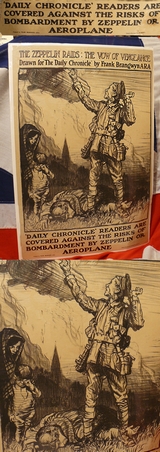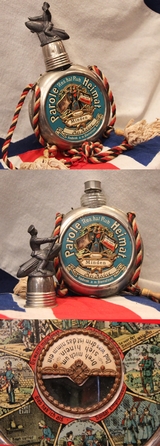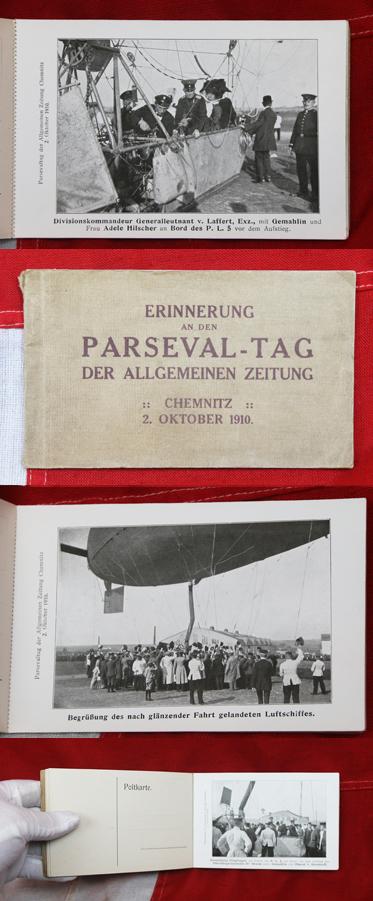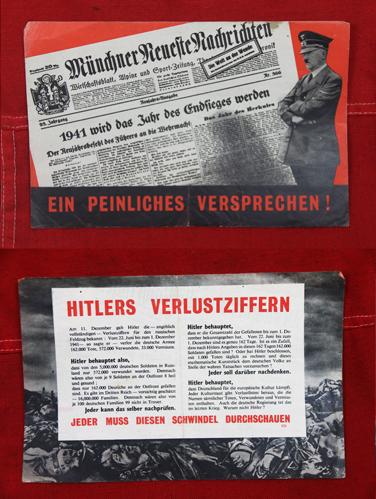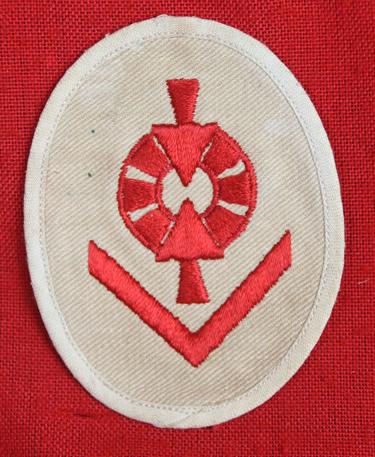WW1 / WW2 / 20th Century
A Most Fine and Rare Original Frank Brangwyn WW1 Propaganda Poster
This is a superb original work of art that would look simply amazing framed and placed in the right setting.
After the June 1915 raids, when air raids intensified, the Daily Chronicle offered its readers £150 for damage to homes and their contents by hostile aircraft, £100 for fatal injuries, £30 for damage inflicted by the enemy but not by air power and £10 to cover medical fees for non-fatal injuries. The Zeppelin Raids: the vow of vengeance. Drawn for "The Daily Chronicle" by Frank Brangwyn A.R.A. 'Daily Chronicle' readers are covered against the risks of bombardment by zeppelin or aeroplane.British infantryman, full-length standing figure, looking up and shaking his fist at a departing Zeppelin. At his feet lies the body of an old woman who is mourned by a small boy and woman, left. In the background a skyline of bomb damaged and smoke shrouded buildings text: "THE ZEPPELIN RAIDS: THE VOW OF VENGEANCE Drawn for 'The Daily Chronicle' by Frank Brangwyn ARA" (in 2 lines upper edge) & "'DAILY CHRONICLE' READERS ARE COVERED AGAINST THE RISKS OF BOMBARDMENT BY ZEPPELIN OR AEROPLANE" printed by The Avenue Press, Ltd., Bouverie St., London, E.C. Original lithograph poster.There are other original surviving examples of this original poster in both the Imperial War Museumin London and the Library of Congress in America. Posters of this kind are rare simply due to the fact they were considered as disposable propaganda artworks and were thus disposed of when no longer needed after the wars end. Brangwyn trained at the Royal College of Art, and was an apprentice with the designer William Morris. A highly regarded and prolific draughtsman, he was an established Royal Academician by the beginning of the First World War.
Frank Pick, General Manager of London Underground and a notable supporter of high quality design, commissioned Brangwyn to produce morale raising posters for London commuters. Brangwyn also worked extensively for war charities, producing many posters in support of Belgian relief, as he had been born in Bruges. Later in the war he contributed to the Ministry of Information's print series 'Efforts and Ideals' and designed posters for the National War Savings Committee.
His emotive realism was often criticised by government officials for demoralising the public. His depiction of close combat in the War Savings poster 'Put Strength in the Final Blow' was published only after some debate. The poster caused a public outcry in Germany, but ironically Brangwyn's reputation was considerably higher on the Continent. He was featured in an illustrated article in the prestigious German poster journal, Das Plakat in 1919.
Moved by the suffering and destruction of the war, Brangwyn later became a pacifist. His career continued to flourish after the war, most prominently as a painter of murals for public buildings. He is celebrated in the Brangwyn Museum in Bruges and the Musee de la Ville at Orange, France also has large holdings of his work. During World War I, the impact of the poster as a means of communication was greater than at any other time during history. The ability of posters to inspire, inform, and persuade combined with vibrant design trends in many of the participating countries to produce interesting visual works. At the start of the twentieth century he was the one British artist whose work was revered by the European cognoscenti, and the Japanese recognised in his artistic endeavours a love of simplicity, geometric compositions, and clarity of colour. He worked for Bing and Tiffany and produced murals for four North American public buildings. A supremely charitable man with a reputation for being irascible; a pacifist whose brutal WWI poster Put Strength in the Final Blow (1918) reputedly led the Kaiser to put a price on his head.
The man whom G K Chesterton described as
‘the most masculine of modern men of genius’ could also produce exquisitely delicate and serene works like St Patrick in the Forest (Christ’s Hospital murals); and his oils are as voluptuous in colour and form as his furniture is minimalist. Original WW1 and WW2 Posters are becoming hugely popular yet some are still very affordable, prices for nice examples are reaching well into the thousands over the past few years now. If a 1920's Russian movie poster of the Battleship Potemkin will fetch over £100,000 GBP, the potential for the values of fine propaganda posters by the great artists of their day could be immense 20 x 30.25 inches read more
625.00 GBP
Very Good Princess Mary Box, Complete With Original Personal Letters, Paperwork and Original Contents To Essex Regiment Regular
It is so rare to have a Mary Box that is not only personally identifiable but with much of original contents complete. This makes this a most exceptional and unique example.
Gifted to '4239, H.Scrutton of the Essex regiment' who served as a regular throughout the Empire from 18th June 1894 to 24th March 1916. He was an 'Old Contemptable' and awarded the 1914 Mons Star, South Africa medal and four bars General Service Medal and LSGC in 1912 plus numerous others. The original Princess Box containing an original and intact tobacco packet, empty cigarette packet, a Christmas card from Princess Mary in its envelope, a photo of Princess Mary, and a signed gift note from the Princess. Plus a note written of Mr Scrutton's military career. The photo shows a Chinese Republic banknote, not connected to the set and sold seperately. They were sent to the British troops in the frontline trenches in WW1 at Christmas 1914. During World War One King George V and Queen Mary got very involved in active war work. The King mainly visited battlefields (as recorded on the King at the Front postcards) while the queen organised clothing drives, visited hospitals and other welfare organisations. Princess Mary, then 18, often accompanied the Queen and according to the book Princess Mary, Viscount Lascelless became intensely concerned, with Christmas looming, about the well-being of the soldiers and sailors serving far from home. With her parents consent the following letter of appeal was published in November 1914.
' For many weeks we have all been greatly concerned for the welfare of the soldiers and sailors who are so valiantly fighting our battles by land and sea. Our first consideration has been to meet their more pressing needs and I have delayed making known a wish that has long been in my heart, for fear of encroaching on other funds, the claim of which have been more urgent. I want you all to help me send a Christmas present from the whole nation to every sailor afloat and every soldier at the Front. On Christmas Eve, when, like the shepherds of old, they were wont to hang out their stockings, wondered what the morrow had in store. I'm sure that we should all be happier to feel that we had helped to send our little token of love and sympathy on Christmas morning something that would be of useful and permanent value, and the making of which may be the means of providing employment for trades adversely affected by the war. Could there be anything more likely to hearten them in their struggle than a present received straight from home on Christmas Day Please will you help me Mary".
In support of this appeal many periodicals of the day published or referred to her letter.
The following example appeared in the Illustrated War News of 4 November 1914 'Princess Mary is appealing for help to send a Christmas present, from the Nation, to every Sailor afloat and every Soldier at the front. Remittance should be addressed to H.R.H. the Princess Mary, Buckingham Palace, S.W., the envelopes marked Sailors and Soldiers Christmas Fund. The appeal was very successful for it had reached 131,000 Pounds by 16 December .It was initially decided that the Gift would be received by every sailor afloat and every soldier at the Front wearing the King's uniform on Christmas Day 1914. The difficulty for the committee was deciding how many to get manufactured. They calculated that 145,000 sailors including Royal Marines and 350,000 soldiers including the Indian Contingent qualified. It was therefore calculated that between 55 and 60,000 pounds would be needed to cover the cost of nearly 500,000 gifts. The final Fund total was reported by the Committee on 30 June 1919 as 193,667 pounds 4s and 10d. Monies from the fund is also reported as having been used, to buy War Bonds and, in War Loans. The funds that remained at the end were apparently transferred to Queen Mary's Maternity Home founded for the benefit of the wives and children of sailors, soldiers and airmen of the newly formed Royal Air Force. Abridged from an original article by Grahame Barber. 2nd Lieutenant R C Leach of the 1st Battalion, King's Own Royal Lancaster Regiment wrote to his mother describing Christmas 1914:
I think we must have had a decidedly more cheerful Christmas than you at home. For a start on getting into billet I found 15 parcels waiting for me. They had a special Post Office bag for them. Well on Christmas morn I spent till about 1.30 issuing presents to the men; both yours which were very welcome and those sent in bulk to be divided amongst the troops, each regiment getting a certain share. There were also Princess Mary's presents which consisted of a packet of cigarettes, a pipe, a packet of tobacco and a Christmas card from King and Queen. Also in the gallery a photo [for information only] of a soldier opening his Princess Mary Gift Tin, Christmas 1914. read more
295.00 GBP
A Most Decorative Imperial German WW1 Soldiers Zeppelin Flask
This is a superb WW1 German Reservists flask (Reservistenflasche). A glass schnapps flask encased in a decorative enamelled metal jacket, with a lanyard in the black, white,black and red colours of the Imperial German Reich. They were made by between 1871 and 1918, for sale to conscripts, wives or sweethearts of soldiers as a memento of their service time. The front and rear of the flask are covered in military themed vignettes, with, a military regimental panel attached to the front, and to the rear a rotating panel surrounded with picture portraits of pretty ladies. The lid is a cup of a soldier sitting astride a Zeppelin that turns to become a drinking cup. Named for the Minden Regt. The figure on the Zeppelin in lacking one arm. read more
245.00 GBP
A Rare King Airship Co. of Washington, USA, an Original & Historic, One Share Stock Certificate, Signed and Dated 7th August 1920
This would make an intriguing a unique gift, especially for a devotee of early aeronautica, and the earliest flying machines, and would look beautiful suitably framed.
On December 17, 1903, the Wright brothers were the first to fly in a powered and controlled aircraft. Previous flights were lighter than air vehicles, gliders (control but no power) or free flight (power but no control), but the Wright brothers combined both, setting the new standard in aviation records.
There have been many booms and busts in the aviation industry. The earliest known aviation stock certificate for a company that actually made a flying airship called the Novelty Air Ship Company in 1888. The Novelty Air Ship Company manufactured the vehicle for Professor Peter C. Campbell who was the inventor. Unfortunately, the air ship was lost at sea in 1889 while being test flown by Professor Hogan during an exhibition flight. This historic document was printed by the Goes Company and has an ornate border around it with a vignette of a Bald eagle. This item has the signatures of the Company’s Secretary and the President and is over 100 years old. read more
235.00 GBP
A Most Rare Airship Parseval Tag 8 Postcard Booklet Set, Chemnitz, Dated 2nd October 1910. a Wonderful Piece of early Airship Aeronautica & Postal Service Ephemera
Parseval day 2nd October 1910, 8 postcard booklet erinnerung an den parseval-tag. Chemnitz
The Parsevals were 22 airships built between 1909 and 1919 by the Luft-Fahrzeug-Gesellschaft (LFG) following the design of August von Parseval. In the 1920s and 1930s, three more airships were built following the Parseval-Naatz (PN) design.
As with the rival Zeppelins, the airships were, in both English and German, referred to by the name of the inventor. (In German, the nouns were masculine, that is, "der Parseval", "der Zeppelin".)
In contrast to the Zeppelins, the Parsevals were non-rigid or semi-rigid airships, with little or no stiffening structure inside the fabric envelope. The Zeppelins had a rigid internal framework made of duralumin. Both types relied on hydrogen gas to provide lift.
Original early Parseval airship postcards are very collectable indeed, and can fetch from £30 to £40 each, but a near complete book of 8 unused cards is really rare to find and a great aeronautical gem, plus with early air post connections read more
245.00 GBP
British WW2 Anti Hitler Propaganda Pamphlet "Ein Peinliches Versprechen" An Embarrassing Promise
From a small former intelligence officer's collection of original surviving WW2 psychological warfare propaganda leaflets we were delighted to acquire.
"ein peinliches versprechen". An air dropped propaganda leaflet pointing out that Hitler prophesied a German victory in 1941, as the Year of Final Victory. Undermining the Fuhrer Myth through Black Propaganda and clandestine means became the stated objective of the OSS.
Leaflets for propaganda, could be dropped by balloons and planes over enemy territory, or, distributed by hand when in occupied or allied territory. They was used heavily in both world wars by all sides. In World War II, special bombs were developed to disperse airborne leaflets. Used as a form of psychological warfare, these leaflets were dropped in enemy-controlled territory to incite fear, coerce surrender, or turn the populace against their leadership. This tactic proved to be largely ineffective, except when morale among troops was extremely low. Leaflet bombs are still used today in military warfare, as well as by radical political and ideological groups.
Toward the end of World War II, Germany dropped millions of propaganda leaflets on enemy lines to encourage troops to surrender. Some of these leaflets were tailored to African American soldiers and suggested they would be treated better as German prisoners of war than as citizens in their own country.
Nazi Germany was not known for its fair treatment of people of African descent, or any persons who weren’t Aryan. Black people were frequently vilified and deemed uncivilised in Nazi propaganda. Yet, Germany was willing to use any tactics necessary to avoid defeat, including highlighting American racism, to exploit existing tensions within the U.S. military..
Although these pamphlets were made in their tens of thousands almost all were destroyed either immediately or at the wars cessation, so few survive and mostly survive today in national archives or museums.
8.25 inches x 5.25 inches read more
35.00 GBP
A Most Interesting & Historical Nazi Propaganda Leaflet Written by Notorious British Nazi and Traitor, John Amery, Who Was Executed At the Wars End
From a small former intelligence officer's collection of original surviving WW2 psychological warfare propaganda leaflets we were delighted to acquire.
An anti-Semitic propaganda leaflet printed in English, by infamous traitor John Amery, the Amery family's black sheep fascist, and the son of Churchill's Secretary of state for India. It was intended for distribution to British soldiers and civilians, a double-sided propaganda leaflet, entitled "Why Die for Stalin? Why die for the Jews?" and authored by British fascist and propagandist JOHN AMERY (1912-1945), who was tried and executed for treason postwar. The leaflet features the usual conspiratorial pabulum explaining that British soldiers are dying fruitlessly for Jewish and communist interests in Italy, Burma and on the Atlantic, while attempting to explain the fruitlessness of hostilities between England and Germany.
Leaflets for propaganda, could be dropped by balloons and planes over enemy territory, or, distributed by hand when in occupied or allied territory. They was used heavily in both world wars by all sides. In World War II, special bombs were developed to disperse airborne leaflets. Used as a form of psychological warfare, these leaflets were dropped in enemy-controlled territory to incite fear, coerce surrender, or turn the populace against their leadership. This tactic proved to be largely ineffective, except when morale among troops was extremely low. Leaflet bombs are still used today in military warfare, as well as by radical political and ideological groups.
Toward the end of World War II, Germany dropped millions of propaganda leaflets on enemy lines to encourage troops to surrender. Some of these leaflets were tailored to African American soldiers and suggested they would be treated better as German prisoners of war than as citizens in their own country.
Nazi Germany was not known for its fair treatment of people of African descent, or any persons who weren’t Aryan. People of colour were frequently vilified and deemed uncivilised in Nazi propaganda. Yet, Germany was willing to use any tactics necessary to avoid defeat, including highlighting American racism, to exploit existing tensions within the U.S. military. And by the wars end they even encouraged foreign Muslims to join the dedicated Muslim waffen SS regiments, which in the 1930's would be unthinkable.
Although these pamphlets were made in their tens of thousands almost all were destroyed, either immediately on landing or at the wars cessation, so very few indeed survive and mostly survive today in national archives or museums.
On 22 June, the Second Armistice at Compiègne was signed between France and Germany. Amery resided in the territory belonging to the collaborationist Vichy government led by Marshal Philippe Pétain. However, his personality soon antagonised the Vichy Regime so he made several attempts to leave but was not allowed. The head of the German Armistice Commission offered Amery a chance to live in Germany to work in the political arena but he was unable to get Amery out of occupied France.
In September 1942, Hauptmann Werner Plack gained Amery the French travel permit he needed, and in October Plack and Amery travelled to Berlin to speak to the German English Committee. It was at this time that Amery suggested that the Germans consider forming a British anti-Bolshevik legion. Adolf Hitler was impressed by Amery and allowed him to remain in Germany as a guest. During this period, Amery made a series of pro-German propaganda radio broadcasts, attempting to appeal to the British people to join the war on communism.
British Free Corps
The idea of a British force to fight the communists languished until Amery encountered Jacques Doriot during a visit to France in January 1943. Doriot was part of the LVF (Légion des Volontaires Français), a French volunteer force fighting alongside the Germans on the eastern front.
Amery rekindled his idea of a British unit and aimed to recruit 50 to 100 men for propaganda purposes and to establish a core of men with which to attract additional members from British prisoners of war. He also suggested that such a unit could provide more recruits for the other military units made up of foreign nationals.
Amery's first recruiting drive for what was initially to be called the British Legion of St George took him to the Saint-Denis POW camp outside Paris. Amery addressed between 40 and 50 inmates from British Commonwealth countries and handed out recruiting material. This first effort at recruitment was a complete failure, but he persisted.
Amery's drive for recruits found two men, of whom only one, Kenneth Berry, joined what was later called the BFC. Amery's link to the unit ended in October 1943, when the Waffen SS decided his services were no longer needed, and it was officially renamed the British Free Corps.
Arrest
Amery continued to broadcast and write propaganda in Berlin until late 1944 when he travelled to Northern Italy to lend support to Italian dictator Benito Mussolini's Salò Republic. On 25 April 1945, Amery was captured along with his French mistress Michelle Thomas by Italian partisans from the Garibaldi Brigade near Como. Amery and Thomas were initially to be executed, but both of them were eventually sent to Milan, where they were handed over to Allied authorities. Amery was wearing the uniform of the "Muti Legion", a fascist paramilitary organisation. The British army officer who took him into custody was Captain Alan Whicker, later known as a broadcaster.
Trial and execution
Amery was tried for treason in London. In a preliminary hearing, he argued that he had never attacked Britain and was an anti-Communist, not a Nazi. At the same time, his brother Julian attempted to show that John had become a Spanish citizen, and therefore would legally be incapable of committing treason against the United Kingdom.
His counsel, Gerald Osborne Slade KC, meanwhile, tried to show that the accused was mentally ill. Amery's sanity was questioned by his own father, Leo, but all efforts to have the court consider his mental state were unsuccessful. Further attempts at a defence were suddenly abandoned on the first day of his trial, 28 November 1945, when to general astonishment, Amery pleaded guilty to eight charges of treason, and was sentenced to death. The trial lasted just eight minutes.
Before accepting Amery's guilty plea, the judge, Mr Justice Humphreys, made certain that Amery realised the only permissible penalty would be death by hanging. After satisfying himself that Amery fully understood the consequences of pleading guilty, the judge announced this verdict:
John Amery ... I am satisfied that you knew what you did and that you did it intentionally and deliberately after you had received warning from ... your fellow countrymen that the course you were pursuing amounted to high treason. They called you a traitor and you heard them; but in spite of that you continued in that course. You now stand a self-confessed traitor to your King and country, and you have forfeited your right to live.
Amery was hanged in Wandsworth Prison on 19 December 1945 by executioner Albert Pierrepoint, who in his autobiography described Amery as "the bravest person I'd ever hanged", and buried in the prison cemetery. Amery actually quipped as he was led to the scaffold, "I've always wanted to meet you, Mr Pierrepoint, though not of course under these circumstances!" In 1996, Julian Amery had his brother's remains exhumed and cremated, scattering his ashes in France.
5 1/2" x 8" read more
185.00 GBP
A Superb Condition and Very Rare WW2 1943 Published Nazi & Vichy-French Propaganda Leaflet, Titled INTUITION With Swastikas and Portrait Photo of Adolf Hitler. Four Pages, Folded
From a small former intelligence officer's collection of original surviving WW2 psychological warfare propaganda leaflets we were delighted to acquire.
With photographs and propaganda quotes from such as Hitler, Goering, and Mussolini, showing the fallacy of their statements
For example; "Le mot dordre de la luftwaffe pour 1940 est; victoire"
translation "The Luftwaffe watchword for 1940 is; victory"
Goering 31st December 1939
"l'amitie entre italiens et allemands deviant tous les jours profinde"
translation "the friendship between Italians and Germans becoming deep every day"
Mussolini 2 December 1942
Leaflets for propaganda, could be dropped by balloons and planes over enemy territory, or, distributed by hand when in occupied or allied territory. They was used heavily in both world wars by all sides. In World War II, special bombs were developed to disperse airborne leaflets. Used as a form of psychological warfare, these leaflets were dropped in enemy-controlled territory to incite fear, coerce surrender, or turn the populace against their leadership. This tactic proved to be largely ineffective, except when morale among troops was extremely low. Leaflet bombs are still used today in military warfare, as well as by radical political and ideological groups.
Toward the end of World War II, Germany dropped millions of propaganda leaflets on enemy lines to encourage troops to surrender. Some of these leaflets were tailored to African American soldiers and suggested they would be treated better as German prisoners of war than as citizens in their own country.
Nazi Germany was not known for its fair treatment of people of African descent, or any persons who weren’t Aryan. Black people were frequently vilified and deemed uncivilised in Nazi propaganda. Yet, Germany was willing to use any tactics necessary to avoid defeat, including highlighting American racism, to exploit existing tensions within the U.S. military..
Although these pamphlets were made in their tens of thousands almost all were destroyed either immediately or at the wars cessation, so very few survive and mostly survive today in national archives or museums.
This one is particularly rare, in fact we haven't seen a surviving example before, certainly not in the past 50 years.
This is also a large size some could be only a few inches in size.
16.25 inches x 10.5 inches un-folded open.
read more
295.00 GBP
German WW2 Kriegsmarine Weapons Control Foreman Speciality Trade Badge
Sonderausbildung Abzeichen für Waffenleitvormann Truppen Ausbildung summer service rig.
On entering Kriegsmarine service all personnel were assigned and trained for a specific career. These careers consisted of a wide variety of speciality trades and functions with some of the careers restricted to certain rank groups. On successful completion of the appropriate training, personnel were issued distinctive career insignia to be worn on the upper left sleeve of the uniforms. For EM/NCO’s the career insignia could be worn combined with the rank insignia or as separate insignia. Enlisted ranks of Matrose up to and including Hauptgefreiter career insignia were generally embroidered on small round bases while NCO ranks of Maat up to and including Oberdeckoffizier career insignia were on larger, vertically oval bases and could come in embroidered or stamped alloy versions. Regulations dictated that the base colour of the insignia was to match the colour of the uniform it was worn on. Of Note: Rank designations were tied to the career the individual was assigned to. The insignia consists of a vertically oval, light weight, ribbed white cotton/rayon blend base with machine embroidered, upward and downward pointing, arrow dial heads superimposed on a circular base with staggered, outer graduation bars, all in bright red cotton threads, with larger red chevron. The outer edge of the white cotton/rayon base has a narrow white rayon reinforcement strip machine stitched in place. read more
38.00 GBP
A Very Desirable Early Neck Ribbon for a German WW2 Knight's Cross of the War Merit Cross
In two pieces. An extremely useful ribbon if one had a Knights Cross of the war Merit Cross lacking its ribbon. New replacement reproduction ribbon is available and relatively inexpensive, but old, early ribbon is another matter entirely.
The Knights Cross of the War Merit Cross was considered to be ranked higher than the German Cross in silver, but below the Knights Cross of the Iron Cross. A medal now valued between £4,000 to £10,000. A total of 118 awards of the Knights Cross of the War Merit Cross with swords, and 137 awards without swords were awarded. Considering the relative rarity of the award compared with the grades of the Knights Cross of the Iron Cross, it took on "extra meaning" it did not necessarily deserve, as it ranked below the Knights Cross of the Iron Cross. For example, Reichsmarschall Hermann Göring made a concerted effort to get Hitler to award him this order, much to Hitler's annoyance. In response, Hitler outlined a series of criteria governing the awarding of this decoration and the philosophy of such awards, and directed that "prominent party comrades" were not to be awarded with the Knights Cross of the War Merit Cross (or similar decorations), and withdrew the proposed awards of this order to Gauleiter Erich Koch and Herbert Backe. Directing his comments at Göring personally, Hitler ordered that such attempts to gain this award be stopped. Also, six persons received two Knights Crosses of the War Merit Cross (each one with and without Swords): Walter Brugmann, Julius Dorpmüller, Karl-Otto Saur, Albin Sawatzki, Walter Schreiber, and Walter Rohlandt. read more
240.00 GBP


